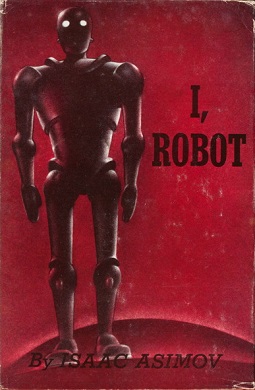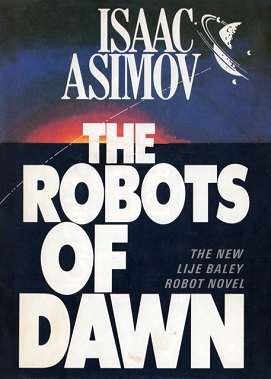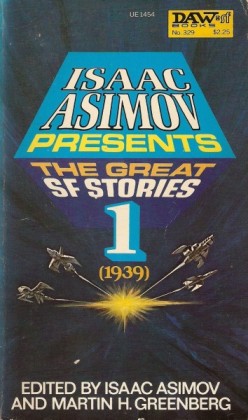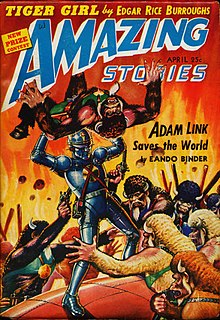
I, Robot is a fixup collection made up of science fiction short stories by American writer Isaac Asimov. The stories originally appeared in the American magazines Super Science Stories and Astounding Science Fiction between 1940 and 1950 and were then collected into a 1950 publication Gnome Press in 1950, in an initial edition of 5,000 copies.

Isaac Asimov was an American writer and professor of biochemistry at Boston University. During his lifetime, Asimov was considered one of the "Big Three" science fiction writers, along with Robert A. Heinlein and Arthur C. Clarke. A prolific writer, he wrote or edited more than 500 books. He also wrote an estimated 90,000 letters and postcards. Best known for his hard science fiction, Asimov also wrote mysteries and fantasy, as well as popular science and other non-fiction.

The Robot series is a series of thirty-seven science fiction short stories and six novels by American writer Isaac Asimov, published from 1940 to 1995. The series is set in a world where sentient positronic robots serve a number of purposes in society. To ensure their loyalty, the Three Laws of Robotics are programmed into these robots, with the intent of preventing them from ever becoming a danger to humanity. Later, Asimov would merge the Robot series with his Foundation series.

The Three Laws of Robotics are a set of rules devised by science fiction author Isaac Asimov, which were to be followed by robots in several of his stories. The rules were introduced in his 1942 short story "Runaround", although similar restrictions had been implied in earlier stories.
A positronic brain is a fictional technological device, originally conceived by science fiction writer Isaac Asimov. It functions as a central processing unit (CPU) for robots, and, in some unspecified way, provides them with a form of consciousness recognizable to humans. When Asimov wrote his first robot stories in 1939 and 1940, the positron was a newly discovered particle, and so the buzz word "positronic" added a scientific connotation to the concept. Asimov's 1942 short story "Runaround" elaborates his fictional Three Laws of Robotics, which are ingrained in the positronic brains of nearly all of his robots.
"Robbie" is a science fiction short story by American writer Isaac Asimov. It was the first of Asimov's positronic robot stories. In 2016, "'Robbie" won a retrospective 1941 Hugo Award for best short story. "Robbie" was the fourteenth story written by Asimov, and the ninth to be published. It was the first story in Asimov's Robot series.
This is a bibliography of the books written or edited by Isaac Asimov, arranged alphabetically. Asimov was a prolific author, and he engaged in many collaborations with other authors. This list may not yet be complete. The total number of books listed here is over 500. Asimov died in 1992 at age 72; a small number of his books were published posthumously.
Eando Binder is a pen name used by two mid-20th-century science fiction authors, Earl Andrew Binder (1904–1966) and his brother Otto Binder (1911–1974). The name is derived from their first initials (E and O Binder). Under the Eando name, the Binders wrote some published science fiction, including stories featuring a heroic robot named Adam Link. The first Adam Link story, published in 1939, is titled "I, Robot".
I, Robot is a 1950 science fiction fixup novel by Isaac Asimov.
This is a list of short stories by American writer Isaac Asimov. Asimov is principally known for his science fiction, but he also wrote mystery and fantasy stories.

"I, Robot" is a science fiction short story by Eando Binder, part of a series about a robot named Adam Link. It was published in the January 1939 issue of Amazing Stories.

Otto Oscar Binder was an American author of science fiction and non-fiction books and stories, and comic books. He is best known as the co-creator of Supergirl and for his many scripts for Captain Marvel Adventures and other stories involving the entire superhero Marvel Family. He was prolific in the comic book field and is credited with writing over 4,400 stories across a variety of publishers under his own name, as well as more than 160 stories under the pen-name Eando Binder.
The Golden Age of Science Fiction, often identified in the United States as the years 1938–1946, was a period in which a number of foundational works of science fiction literature appeared. In the history of science fiction, the Golden Age follows the "pulp era" of the 1920s and 1930s, and precedes New Wave science fiction of the 1960s and 1970s. The 1950s are, in this scheme, a transitional period. Robert Silverberg, who came of age in the 1950s, saw that decade as the true Golden Age. According to historian Adam Roberts, "the phrase Golden Age valorises a particular sort of writing: 'Hard SF', linear narratives, heroes solving problems or countering threats in a space-opera or technological-adventure idiom."
"I, Robot" is an episode of the original The Outer Limits television show. It first aired on 14 November 1964, during the second season. It was remade under the same title in 1995. Leonard Nimoy appeared in both versions.
William F. Wu is a Chinese-American science fiction, fantasy, and crime author.
William Carl Schelly was an Eisner Award-winning author who chronicled the history of comic books and comic book fandom, and wrote biographies of comic book creators, including Otto Binder, L.B. Cole, Joe Kubert, Harvey Kurtzman, John Stanley, and James Warren as well as silent film comedian Harry Langdon.
"Farewell to the Master" is a science fiction short story by American writer Harry Bates. It was first published in the October 1940 issue of Astounding Science Fiction on page 58. It provided the basis of the 1951 film The Day the Earth Stood Still and its 2008 remake. In 1973, the story was adapted by Marvel Comics for its Worlds Unknown series. According to Gizmodo, the 1973 adaptation was more faithful to the original story than was the 1951 film.

Isaac Asimov Presents The Great SF Stories 1 (1939) is an American collection of short stories, edited by Isaac Asimov and Martin H. Greenberg, originally published by DAW books in March 1979. It contains science fiction stories selected by the editors that were published in the year 1939. The book is part of a 25 volume series. Each successive volume in the series contains stories from the next year, continuing through 1963. The series starts with 1939 because Asimov had previously published a three volume anthology series titled, "Before the Golden Age", covering years 1931 - 1938, which he considered to be definitive for those years. According to DAW, The Great SF Stories 1 (1939) "is the first in what Isaac Asimov plans to be a definitive series of sf anthologies, covering year by year the truly memorable stories that have progressively brought science fiction to its present prominence". The second volume of the series is Isaac Asimov Presents The Great SF Stories 2 (1940).
John Binder was a Golden Age comics creator and art packager. A fine artist by education, Binder had a prolific comics career that lasted primarily from 1937 to 1953, through his most concentrated work was through 1946. He was the creator of the original comic book Daredevil, for Lev Gleason Publications. Binder is credited with coining the term zero gravity as part of a 1938 article in Thrilling Wonder Stories. Binder's younger brothers were Earl and Otto Binder, collectively known as Eando Binder when writing science fiction.
In a writing career spanning 53 years (1939–1992), science fiction and popular science author Isaac Asimov (1920–1992) wrote and published 40 novels, 383 short stories, over 280 non-fiction books, and edited about 147 others.







